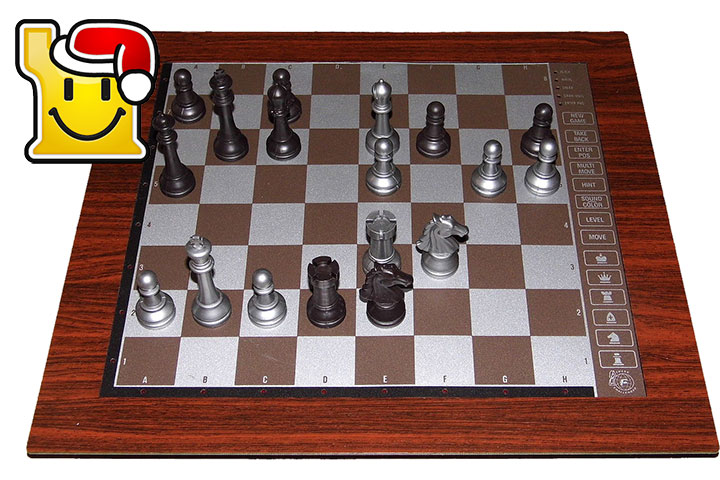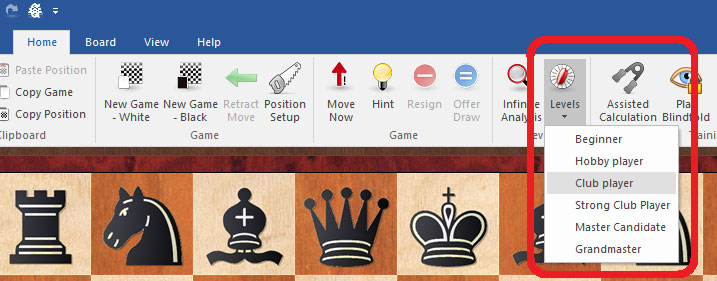


For a while, the idea of an expert or master level computer opponent was the ultimate dream. Fancy wooden machines with plenty of functions would bring the latest iterations and some could even move their own pieces. Playing them was a challenge, and entertaining, but by no means insurmountable.
The Novag Robot Adversary was one of the most spectacular options, with a robotic arm that would move and capture pieces
Those days zipped by so fast that nowadays even a modern smartphone can make mincemeat of the World Champion if it is not handicapped somehow. And that is for the 2800 gods that walk among us. Imagine for the rest of us mortals.
Of course, the option to handicap the program is nothing new, but unlike when facing a stronger human opponent who can calibrate their play more sensibly, weaker computer levels have often played in ways that seemed quite strange, if not outright ridiculous. For five or six moves they would be playing a brand of chess we can only aspire to, and suddenly for no reason they would hang a pawn or a piece. It just wasn’t any fun.
Among the most important new features in Fritz 16 is a series of functions designed to bring back the fun in playing against a program.
The opening screen of Fritz 16 is where you start, and we just click on Easy Game to get started.

The Opening screen already makes the differences clear. Instead of the detailed menus with all the functions, we see just the necessary to play our game. The Levels button will help us choose our level of opposition, and we can see everything from Beginner to Grandmaster. The default is ‘Club player’. If you find it too hard, by all means choose a weaker player, and if it is too easy, you can increase it.

Let’s leave the default on and start a game. After about 13 moves in a Petroff, the cute Fritz icon tells me I am slightly better, and shows an unhappy face. Ten more moves into the game, and not only does Fritz tell me I am slightly better, but also starts to give its first Elo evaluation of my play. This is just a rough estimate, and will be subject to plenty of adjustments down the road.

Small hints and visual queues increase the fun
Not only will it show you the current evaluation, to help you know how you are doing, but the bar chart in the middle will also give a quick visual overview of how the game has been going.
To be fair, the default level is very easy, and at the end of the game, it congratulates me with good grace. (“Now you’re going to get a war you won’t believe!”)

However, what impresses is that at no point did it hang a piece or pawn outright, and just played normal looking moves, even if they were weak.
Naturally, playing the program offers the usual fare of options such as a takeback (Retract move), Hint, and more. But there are some more interesting options to help you in your game without outright telling you what to play. If you enable the Assisted Analysis, you will see.

Just check Assisted Analysis at the right of the main buttons to enable
In the position above, Fritz has just played 13…d4. I am very unsure of what to play. Should I move my bishop somewhere? Let’s ask Fritz what it thinks. To do this, I just click on the bishop with the mouse, as if I were about to move it someplace, and wait a second.

Keeping the mouse button pressed on the bishop shows me the quick evaluation of each square available to it
The bishop, as we can see is a strong choice, and Be4 is clearly among my best plays available.
This sort of suggestion is a considerable step up from the usual Hints that most programs offer, in which they just tell you what to play. This way you can ask about the piece you want to play, and have a rough feel about what Fritz thinks.
 As you can see, with these new calibrated levels, you will have a very manageable opponent, accessible to players of all levels. You can use the Assisted Analysis for a hint here and there, and while you are playing, Fritz will tell you how you are doing in the game, whether better or worse. The Elo evaluation is a nice touch that can inspire you to try for more.
As you can see, with these new calibrated levels, you will have a very manageable opponent, accessible to players of all levels. You can use the Assisted Analysis for a hint here and there, and while you are playing, Fritz will tell you how you are doing in the game, whether better or worse. The Elo evaluation is a nice touch that can inspire you to try for more.
So, is this not an ideal holiday gift to a friend, or for yourself?
| Advertising |